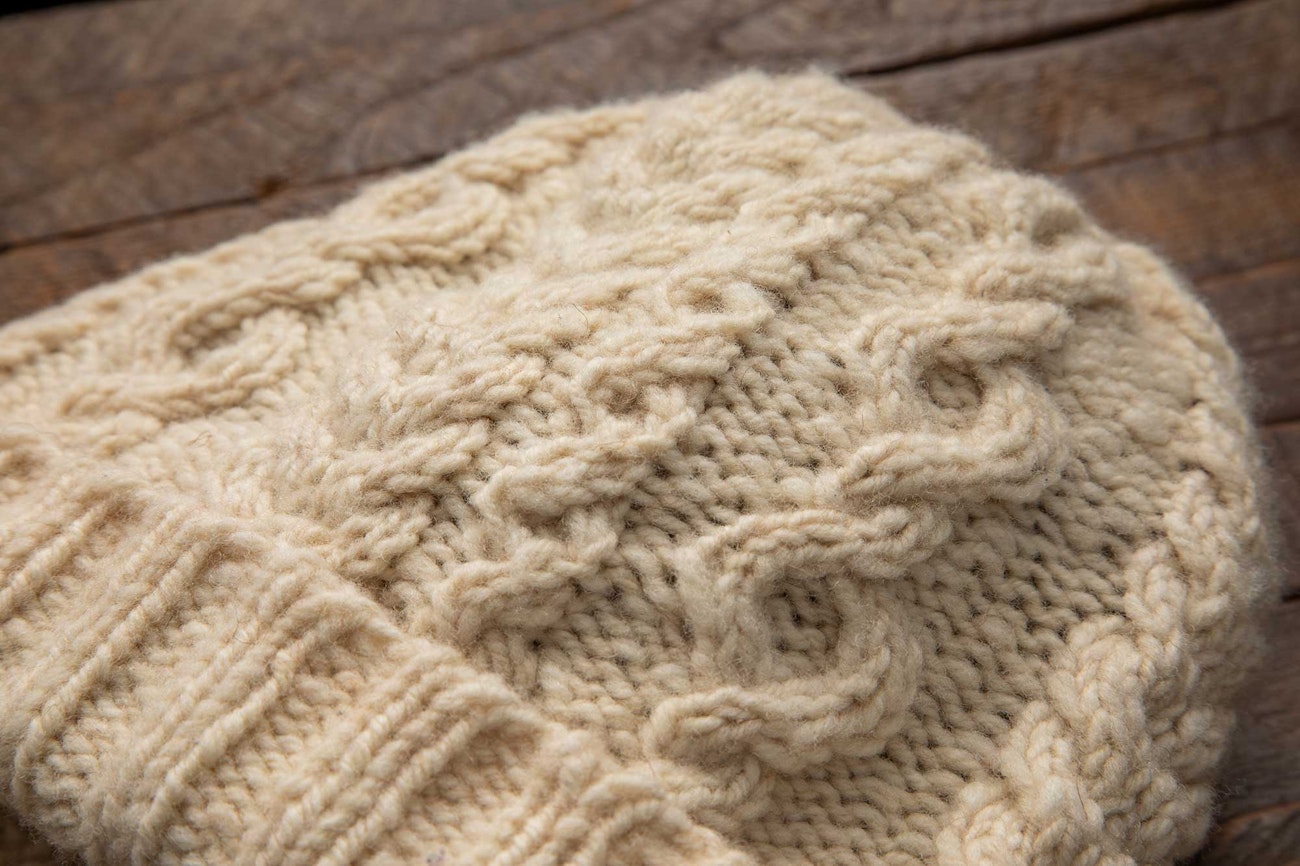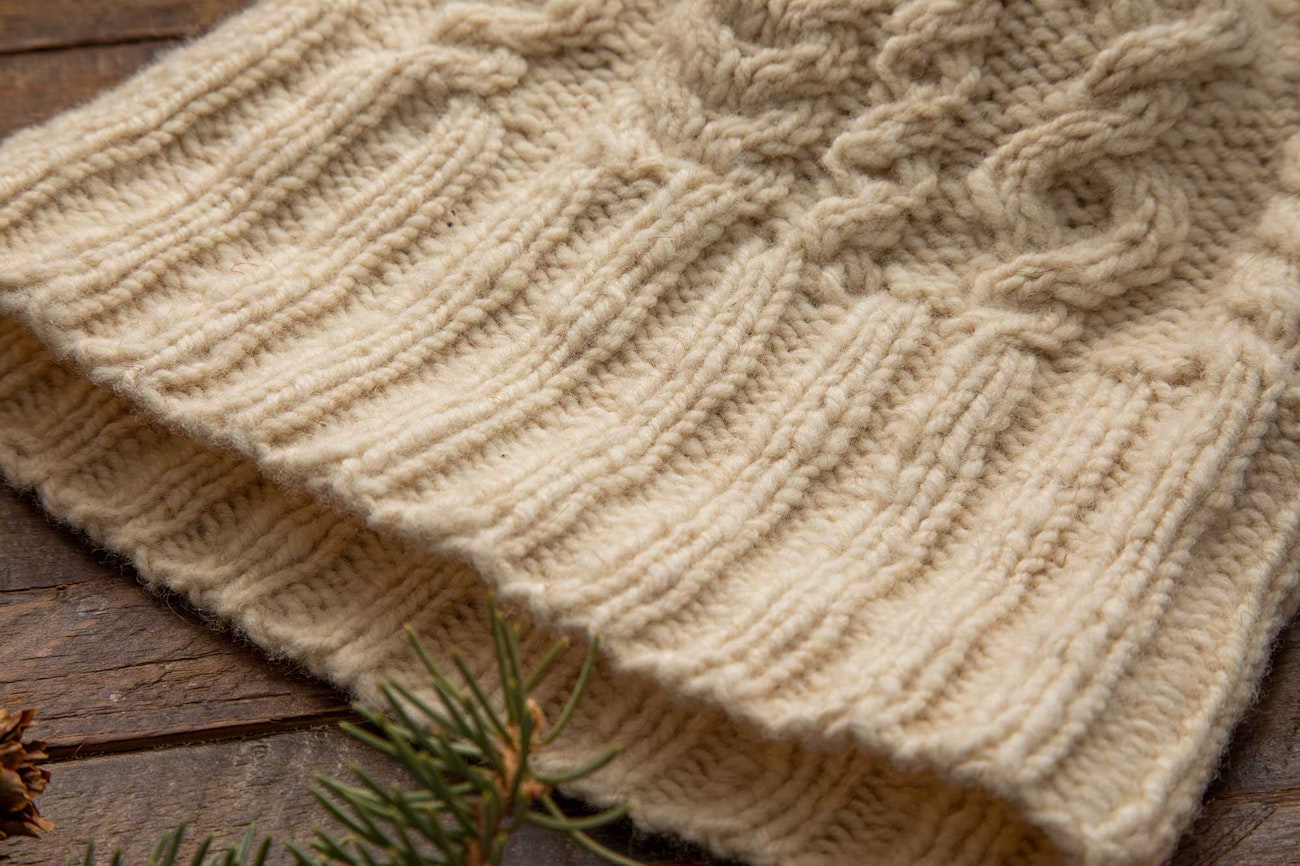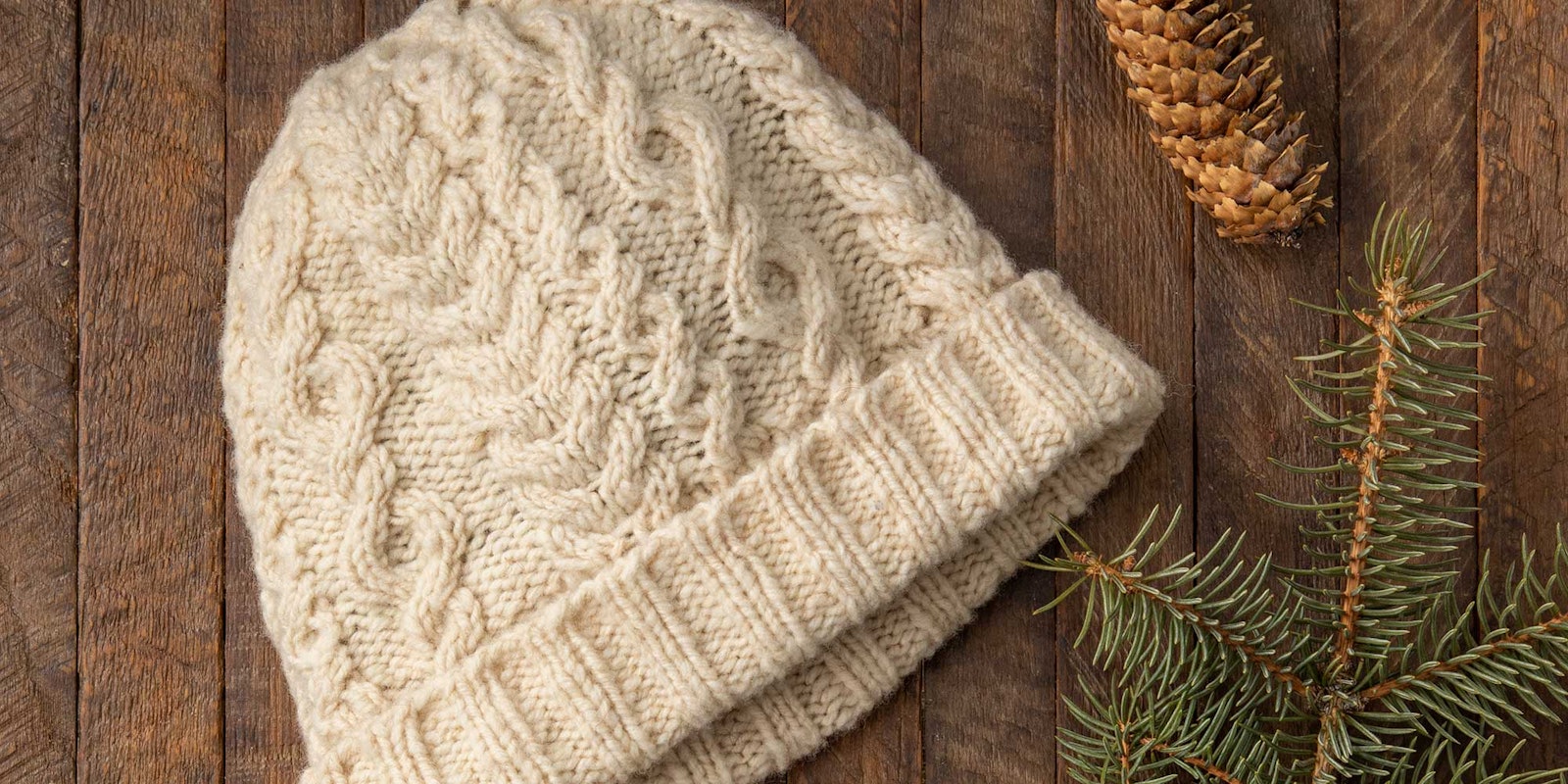https://spinoffmagazine.com/cdn-cgi/image/format=auto/https://www.datocms-assets.com/75073/1656654925-towline-hat.jpeg?auto=format&w=900
It’s been a year, hasn’t it? Virtually everyone I know experienced a 2021 that was jammed with changes, adjustments, readjustments, losses, and joys. Spending some time at the wheel (or charkha or spindle) as one calendar year changes to another helps me process what has been and what is to come. Spinning leaves me feeling lighter, even if I’m returning to heavy things.
Our wish for you on the cusp of 2022 is that you give yourself the gift of time to spin! As a thank you—and a nudge to pull 5 ounces of squishy indulgence from your stash—we are releasing a new knitting pattern by Kerry Bullock-Ozkan, the Towline Hat. This is the perfect quick project to start the New Year off in the right direction. Begin as you intend to proceed!
Kerry is a professional knitwear designer. She created this toasty hat using a bouncy, 3-ply yarn she spun from American Tunis roving purchased from Tarheelbilly Farm. Charis Walker and her family raise Tunis sheep, Galloway cows, bees, and more in Ohio. Charis will share more here about her flock and farm in the new year.
Best wishes to all of you from all of us at Long Thread Media!
—Kate Larson and the Spin Off team
Towline Hat
Kerry Bullock-Ozkan
Cables aren’t necessarily the first thing that comes to mind when thinking of projects for woolen-spun yarns. Smooth, round worsted-spun yarns are usually recommended for making cables pop. But after sampling this Tunis lambswool from Tarheelbilly Farm, I immediately thought of knitting a hat with squishy cables similar to the Aran wool hats my mother and I once wore.
I purchased 5 ounces of 100% American Tunis lambswool roving as part of the Shave ’Em to Save ’Em challenge. According to The Fleece and Fiber Sourcebook, Tunis is a dual-purpose breed with an interesting history. Tunis lambs have a reddish color to their wool when born, which fades to a creamy white over time. The fiber was soft and bouncy, with a warm cream color and medium staple length, and fluffed up pleasantly when finished.

Kerry used a three-ply yarn construction to add stitch definition. Photos by Matt Graves
Spinning Notes
I spun the sample from roving with minimal preparation, only shaking the fiber out a bit to loosen it up. I choose to make a woolen-spun three-ply for several reasons. I think the bounce and crimp of the fiber paired with the loft resulting from the woolen spinning helped to make up for the loss of stitch definition due to the slightly fuzzy surface of a woolen yarn. The three-ply yarn structure also gives a nice roundness and height to the cables.
SUBSCRIBER EXCLUSIVE
It’s been a year, hasn’t it? Virtually everyone I know experienced a 2021 that was jammed with changes, adjustments, readjustments, losses, and joys. Spending some time at the wheel (or charkha or spindle) as one calendar year changes to another helps me process what has been and what is to come. Spinning leaves me feeling lighter, even if I’m returning to heavy things.
Our wish for you on the cusp of 2022 is that you give yourself the gift of time to spin! As a thank you—and a nudge to pull 5 ounces of squishy indulgence from your stash—we are releasing a new knitting pattern by Kerry Bullock-Ozkan, the Towline Hat. This is the perfect quick project to start the New Year off in the right direction. Begin as you intend to proceed!
Kerry is a professional knitwear designer. She created this toasty hat using a bouncy, 3-ply yarn she spun from American Tunis roving purchased from Tarheelbilly Farm. Charis Walker and her family raise Tunis sheep, Galloway cows, bees, and more in Ohio. Charis will share more here about her flock and farm in the new year.
Best wishes to all of you from all of us at Long Thread Media!
—Kate Larson and the Spin Off team
Towline Hat
Kerry Bullock-Ozkan
Cables aren’t necessarily the first thing that comes to mind when thinking of projects for woolen-spun yarns. Smooth, round worsted-spun yarns are usually recommended for making cables pop. But after sampling this Tunis lambswool from Tarheelbilly Farm, I immediately thought of knitting a hat with squishy cables similar to the Aran wool hats my mother and I once wore.
I purchased 5 ounces of 100% American Tunis lambswool roving as part of the Shave ’Em to Save ’Em challenge. According to The Fleece and Fiber Sourcebook, Tunis is a dual-purpose breed with an interesting history. Tunis lambs have a reddish color to their wool when born, which fades to a creamy white over time. The fiber was soft and bouncy, with a warm cream color and medium staple length, and fluffed up pleasantly when finished.

Kerry used a three-ply yarn construction to add stitch definition. Photos by Matt Graves
Spinning Notes
I spun the sample from roving with minimal preparation, only shaking the fiber out a bit to loosen it up. I choose to make a woolen-spun three-ply for several reasons. I think the bounce and crimp of the fiber paired with the loft resulting from the woolen spinning helped to make up for the loss of stitch definition due to the slightly fuzzy surface of a woolen yarn. The three-ply yarn structure also gives a nice roundness and height to the cables.
[PAYWALL]
I spun the singles with a long draw on a spinning wheel with a ratio of 9:1, aiming for a worsted-weight finished yarn. I plied with a tighter twist angle of approximately 45 degrees in order to maximize the roundness and bounce of the yarn. This technique works well when spinning such bouncy, squishy yarns. I finished the yarn by soaking it in hot water with a bit of Eucalan before thwacking it against a table. The final yarn came in at 9 wpi with a grist of about 650 yards per pound. Knit at the pattern gauge, it makes a very dense, warm hat perfect for the coldest winter days.
The hat is knitted in the round from the bottom up, beginning with an optional alternate cable cast on and a long, ribbed brim to fold up for maximum warmth. The cable section can be worked from the charts or written instructions.
Resources
Robson, Deborah and Carol Ekarius. The Fleece & Fiber Sourcebook. North Adams, MA: Storey Publishing, 2011.
Tarheelbilly Farm, tarheelbillyfarm.com.
Download this pattern as a PDF in the Spin Off Library: Towline Hat
MATERIALS
Fiber Tarheelbilly Farm, 100% American Tunis, 5 oz (141.5 g).
Yarn 3-ply; 182 (227) yd; about 650 ypp; 9 wpi; worsted weight.
Needle Size 7 (4.5 mm) 16" (40 cm) circular and set of dpns. Adjust needle size if necessary to obtain the correct gauge.
Notions Marker (m); cable needle; tapestry needle.
Gauge 23 sts and 30 rnds = 4" in Cable patt, blocked.
Sizes S/M (L/XL), to fit 18"–21" (22"–24") head circumference.
Finished Size 17" (21¼") circumference x 10¼" long with brim unfolded.
Visit spinoffmagazine.com/spin-off-abbreviations for terms you don’t know.
Notes
• The smaller size will stretch to fit up to a 22" head circumference with a snug fit. If you prefer a looser fit, choose the larger size.

The ribbed brim is designed to be folded up when worn. Work fewer rounds of ribbing if you prefer a short brim.
STITCH GUIDE
Alternate Cable Cast On
Place a slipknot on left needle. Insert right needle knitwise into slipknot, wrap yarn as if to knit, and pull through, placing new stitch on left needle. You now have 2 stitches on the left needle. * With yarn in front (wyf), slip right needle between the first two stitches on left needle from the back, wrap as for a purl stitch, and pull through, placing stitch on left needle; with yarn in back (wyb) slip right needle between the first two stitches on the left needle from the front, wrap as for a knit stitch, and pull through, placing stitch on left needle. Repeat from * until you have the desired number of cast-on stitches on the left needle.
Alternate Cable Cast On for 2×2 Rib
Work alternate cable cast on, above. You will have a series of alternating knit and purl stitches on the left needle, ready to work 1×1 rib. To set up for 2×2 rib, work the first row flat, as fol-lows: * K1, sl 2nd st on left needle to right needle, dropping 1st st; place 1st st and then the 2nd st (in reverse order) back on left needle, k1, p2. Repeat from * until all stitches have been worked, treating the slipknot as a purl stitch.
Cable Pattern (multiple of 24 sts)
Rnd 1 [P3, k4] 2 times, p1, k8, p1.
Rnd 2 P3, 2/2 RC, p3, 1/1 LC, 1/1 RC, p1, 2/2 RC, 2/2 LC, p1.
Rnd 3 Repeat Rnd 1.
Rnd 4 P3, k4, p3, 2/2 RC, p1, k8, p1.
Rnd 5 Repeat Rnd 1.
Rnd 6 P3, 2/2 RC, p3, 1/1 RC, 1/1 LC, p1, 2/2 RC, 2/2 LC, p1.
Rnd 7 Repeat Rnd 1.
Rnd 8 P1, 2/2 RPC, 2/2 LPC, p1, 1/1 LC, 1/1 RC, p1, k8, p1.
Rnd 9 P1, k2, p4, k2, p1, k4, p1, k8, p1.
Rnd 10 P1, k2, p4, k2, (p1, 2/2 RC) 2 times, 2/2 LC, p1.
Rnd 11 Repeat Rnd 9.
Rnd 12 P1, 2/2 LPC, 2/2 RPC, p1, 1/1 RC, 1/1 LC, p1, k8, p1.
Crown Pattern
Rnd 1 P2, k4, p2tog, p1, k4, k2tog, k7, p2tog—84 (105) sts.
Rnd 2 P2, 2/2 RC, p2, 1/1 LC, 1/1 RC, 2/2 RC, 2/2 LC, p1.
Rnd 3 P2tog, k4, p2tog, k11, ssk—72 (90) sts.
Rnd 4 P1, k4, p1, 2/2 RC, k8.
Rnd 5 [K2tog, k3] 2 times, k2tog, k4, ssk—56 (70) sts.
Rnd 6 2/2 RC, 1/1 RC, 1/1 LC, 2/1 RC, 2/1 LC.
Rnd 7 *K2tog; rep from * to end—28 (35) sts.
HAT
Brim
Using Alternate Cable Cast On for 2×2 Rib (see Stitch Guide), or your preferred cast on for rib-bing, CO 88 (112) sts. Place marker (pm) and join in the rnd.
Rnd 1 * K2, p2; repeat from * to end.
Continue working in 2×2 rib as established for 27 more rnds or until hat measures 4" from cast-on edge.
Body
Size S/M only
Inc rnd K2, p2, M1, * [k2, p2] 3 times, M1; repeat from * to end—96 sts.
Size L/XL only
Inc rnd [K2, p2] 2 times, M1, * [k2, p2] 4 times, M1; rep from * to last 8 sts, [k2, p2] 2 times, M1—120 sts.
Both Sizes
Work Rnds 1–12 of Cable patt 3 times or until hat measures 8¾" from CO, ending with Row 12. Hat should measure approximately 1½" less than desired length.
Crown
Remove m, sl 1st st pwise to right needle, replace m. Work Rnds 1–7 of the Crown, switching to dpns when the circumference becomes too small—28 (35) sts after Rnd 7.
Next rnd * K2tog; rep from * to last 0 (1) st(s), k0 (1)—14 (18) sts.
Final dec rnd * K2tog; repeat from * to end—7 (9) sts rem.
FINISHING
Break yarn, leaving a tail about 6" long. Thread tail through remaining stitches twice and bring to inside of hat.
Weave in ends. Block to measurement.
Kerry Bullock-Ozkan is a knitwear designer and textile artist living in the beautiful Piedmont region of North Carolina. She loves working with local fibers and breed-specific wool to create modern, wearable garment and accessory designs. Follow her adventures in spinning all the breeds at bullockozkandesigns.com.
Originally published December 31, 2021, updated September 17, 2025



